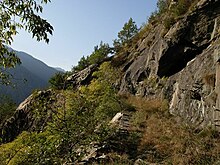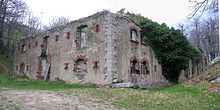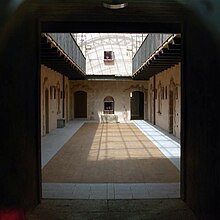Machaby Fortress
| Machaby Fortress | ||
|---|---|---|
|
Caserma Licini after the restoration |
||
| Creation time : | 1880-1885 | |
| Castle type : | fortress | |
| Conservation status: | restored | |
| Construction: | Quarry stone and brickwork , plastered | |
| Place: | Arnad | |
| Geographical location | 45 ° 38 '2.2 " N , 7 ° 44' 33.6" E | |
| Height: | 718 m slm | |
|
|
||
The fortress of Machaby ( Italian Forte di Machaby ) is a fortress that is an outpost of the fortress of Bard on a promontory of Machaby in the municipality of Arnad in the Aosta Valley . It dates from the 17th and 18th centuries. The complex is close to the Sanctuary of Notre-Dame-des-Neiges and the old Machaby settlement and is easily reached in a 20-minute walk along a stretch of the 19th century military road. The facility, which was converted into accommodation after five years of restoration in the 2000s, is partially open to the public during the opening hours of the hostel and the Centro di Formazione Alpinistica .
history
17th-19th century
The genius troupe built around 1880-1885 the defense barracks Machaby on the remains of an old military fort from the 17th century in a strategic position to monitor the area of Arnad and the valley of the Dora Baltea . The factory garrison was in the barracks, while, a little above, the engineering troops set up the battery of the village of Lo Fort , also known as Batteria di Machaby ; it was armed with 6 cannons of the type 149 G, which served to prevent enemy troops from taking the fort of Bard by surprise on its weakest flank, the right. Gradually, the engineering team built another battery on the summit of Tête de Cou and this was also equipped with 6 cannons, Type 149 G.
20th century
The fortress, which had long been the logistical seat for the summer training camps of the Alpini- Battaillon Aosta, was gradually abandoned.
The fortifications have left traces in the memory of the oldest inhabitants of Arnad, who in a number of reports set out how the fortress was in its last days of operation:
"Il forte militare sopra Matsabé l'hanno costruito nel 1888, c'erano dei soldati ed avevano anche dei cannoni ed ho sentito raccontare che ogni tanto sparavano, poi durante la guerra del 1915-18 sono venuti molti soldati ed hanno fatto scendere i canno giù per la roveu'a . Al kouarté c'erano delle compagnie di militari, facevano semper delle grandi quantità di pasta e molti venivano su dal paese con dei barakin per prendere la pasta che i soldati avanzavano, tanto loro l'avrebbero buttata, qualcuno per mangiarla ed altri per darla maiali (...) “ (Eng .: The military fortress over Machaby was built in 1888; there were soldiers and they also had cannons and I heard that they shot every now and then; later, during the First World War , many soldiers came and they sent the cannons down the landslide. There were companies in the barracks who always made large quantities of noodles, and many came from the village with small pots to fetch the noodles left by the soldiers, otherwise they would have thrown it away; [some took] to eat [themselves], some to give to the pigs. (...)) Testimony of Bonel Lugia , b. 1906.
"Mi ricordo molto bene dei soldati che erano di guardia alla caserma di Matsabé, al forte ed al forte di La Cou. Ultimamente erano in pochi e una donna di Bard che chiamavano Gin è stata l'ultima guardiana. Il kouarté era allora molto ben tenuta con delle belle stanze con il pavimento in legno, la hiterna per l'acqua e più sotto c'erano anche degli orti coltivati. I militari sono rimasti fino al 1920-22 ma la caserma è semper stata chiusa a chiave fino all'ultima guerra. (...) “ (German: I can very well remember the soldiers who were on guard at the Machaby barracks, at the fortress and at the fortress of '' La Cou '') there were only a few of them and a woman from Bard, who they called “gin.” The barracks were then very well maintained with beautiful rooms with wooden floors, the cistern for the water and further down there were also cultivated gardens. The military stayed until 1920–1922, but the barracks were always cordoned off until the last war. (...)) Testimony from Rolland Gasparina , b. 1915.
In February 1968 the municipality of Arnad bought the fortress, which it took over from the Republic of Italy.
21st century
In 2005, part of the 19th century military road was blocked by a landslide that interrupted the connection with the SS 26 near Arnad, about 500 meters above sea level. The path that connects with the road from Castello Vallaise to the sanctuary of Machaby has not been interrupted .
The exact restoration of the fortress, which began in winter 2005/2006 and was completed in October 2010, was carried out on behalf of the municipality of Arnad in order to promote tourism in the lower Aosta Valley. The work swallowed up a sum of € 1.8 million, of which 20% came from the municipality and 80% from the FOSPI regional funds. Following a tender, the new accommodation inside the fortress was entrusted to the administration. The property was inaugurated in March 2012 and allows the fortress to be opened for a few months each year.
description
The complex consists of the barracks “Tenente Lucini”, the “Batteria di Machaby” and the “Batteria del Colle La Cou”.
Barracks "Tenente Lucini"
The barracks "Tenente Lucini" at 717 meters above sea level is surrounded by a centuries-old chestnut forest and has been home to accommodation in an attached hostel and the Centro di Formazione Alpinistica since the 2010s , near the natural climbing garden of Machaby, the cliff called " Paretone ”. During the restoration in the 2000s, the original structure was preserved wherever possible, with a clear polycarbonate roof spanning the courtyard, as well as renewable energy facilities on site , giving it a 90- Grant% energy autonomy: A photovoltaic system and a geothermal system have been installed and the rainwater is collected.
inside rooms
This is how the barracks was described in the magazine "Environnement" after the restoration:
“Al piano terreno troviamo una zona comune, l'alloggio del conduttore, i servizi igienici, l'atrio di ingresso, la cucina, una camera per il personale, due sale da pranzo comunicanti, un soggiorno ed il locale caldaia. Al centro della struttura, il cortile interno risulta protetto da una struttura in policarbonato che permette so di utilizzare lo spazio also in caso di intemperie. Al primo piano sono state ricavate le camere per gli ospiti ei servizi comuni, oltre a due camere per gli accompagnatori con annesso servizio. ” ( Eng . : On the ground floor you will find a communal zone , the apartment of the head of the facility, the service rooms, the entrance courtyard , the kitchen, a staff room, two connected dining rooms, a lounge and the boiler room. In the middle of the building, the inner courtyard is protected by a polycarbonate roof, which allows this room to be used even in bad weather. The bedrooms and ancillary rooms are located on the upper floor , as well as two rooms for accompanying persons with adjoining rooms.)
Batteria Machaby
The "Batteria Machaby" is 843 meters above sea level and is in ruins; she had placed cannons in the open air (in a gun bank ). In addition to the spaces for the cannons, a Contrescarpe wall and a wide moat have been preserved.
Batteria del Colle La Cou
The "Batteria del Colle La Cou" at 1425 meters above sea level is practically completely destroyed today. It is about 1½ hours' walk on a multi-path from the Batteria Machaby on the summit of Tête de Cou . Only a few remains of the cannon battery are preserved on the gun bank.
Individual references and comments
- ↑ a b c Il Forte. (No longer available online.) In: Forte di Machaby. Archived from the original on November 5, 2013 ; accessed on August 21, 2020 .
- ↑ There is also a prehistoric “women's slide” near the fortress.
- ↑ Lo scivolo della fertilità di Châtillonet. Ayas Trekking, accessed August 21, 2020 .
- ↑ a b Forte di Machaby. In: Castelli. Regione Autonoma Valle d'Aosta, accessed on August 21, 2020 .
- ↑ The fortress of Bard was rebuilt in the years 1830–1838 after it was shaved to the ground on the orders of Napoleon . The reservist army, which had to bypass the fortress from May 19 to June 1, 1800, withdrew because they had not crossed the valley behind Arnad, but had stayed deeper, behind Barma di Ban , and from there on a path, which is now overgrown and impassable, has risen to the hamlet of Albard di Bard . The battery was equipped with cast-iron bolt loading cannons of caliber 150 mm with a range of 8000 meters.
- ↑ a b c d Mauro Minola, Beppe Ronco: Valle d'Aosta. Castelli e fortificazioni . Macchione, Varese 2002, ISBN 88-8340-116-6 , p. 65.
- ^ A b E. Noro, A. Champurney: Arnad in Valle d'Aosta quasi un secolo di memoria . Priuli & Verlucca, pp. 116, 201, cited in
- ↑ a b c d e Yuri Costabloz: Il recupero del Forte di Machaby. In: Environnement. Ambiente e territorio in Valle d'Aosta, No. 52/2011. Accessed August 21, 2020 .
- ↑ a b Moreno Vignolini: Ad Arnad si inaugura il nuovo ostello. (No longer available online.) In: Aosta Sera. October 26, 2010, archived from the original on November 5, 2013 ; accessed on August 21, 2020 .
- ↑ Inaugurazione dell'Ostello - Centro di Formazione Alpinistica "Forte Tenente Licini" di Machaby. (No longer available online.) CAI , Turin Section, March 26, 2012, archived from the original on November 5, 2013 ; accessed on August 21, 2020 .
swell
- Mauro Minola, Beppe Ronco: Valle d'Aosta. Castelli e fortificazioni . Macchione, Varese 2002, ISBN 88-8340-116-6 , pp. 62-68.
- Yuri Costabloz: Il recupero del Forte di Machaby. In: Environnement. Ambiente e territorio in Valle d'Aosta, No. 52/2011. Accessed August 21, 2020 .
- Dario Gariglio, Mauro Minola: Le fortezze delle Alpi occidentali . L'Arciere, 1994.
Web links
- Forte di Machaby. Accessed August 21, 2020 .
- Gian Mario Navillod: Strada militare Bard Machaby. Tapazovaldotes, accessed August 21, 2020 .







